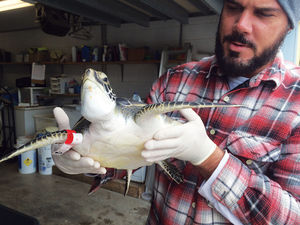
The Atlantic green sea turtles off the Island coast felt last weekend’s cold blast as much as the human population here. As of Monday afternoon, almost 70 juvenile cold-stunned turtles washed ashore on the Island’s bay side of South Padre Island, Sea Turtle Inc.’s assistant curator Kat Lillie said. “Cold stunning is a form of hypothermia,” she said.
According to the National Oceanic and Atmospheric Administration Fisheries Service, the reaction occurs when sea turtles are exposed to prolonged cold water temperatures. Initial symptoms include a decreased heart rate, decreased circulation and lethargy, followed by shock, pneumonia and possibly death. “When sea turtles are in this state they float and move very little, making them vulnerable to boat strikes,” Lillie said.
As cold-blooded reptiles that depend on external heat sources to determine their body temperature, sea turtles do not have the ability to warm themselves and must migrate to warmer water, she said.
Most of the turtles were found in the bay because that’s their preferred habitat, she said.
Information on the Sea Turtle Inc. website states, green sea turtles are generally found in shallow waters along reefs, in bays and estuaries. They are found throughout the world, predominantly in tropical and subtropical waters.
KAYLEIGH SOMMER




